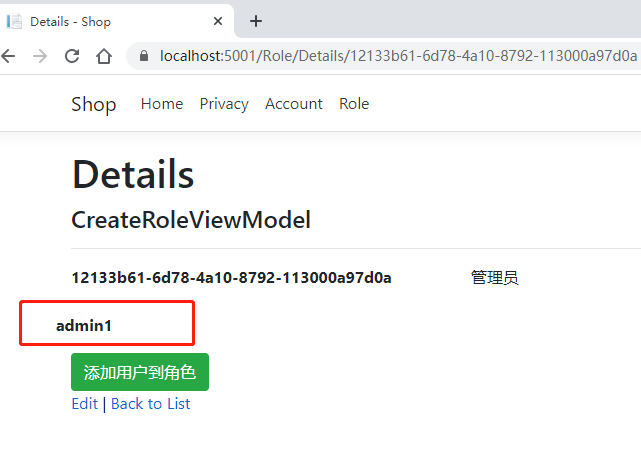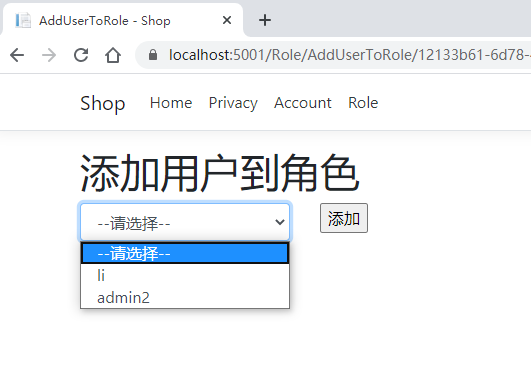Identity角色管理五(添加用户到角色组)
因需要在用户列表中点详情按钮来到当前页,所以需要展示分组详情,并展示当前所属角色组的用户
public async Task<ActionResult> Details(string id) { //查找是否存在角色组 var role = await _roleManager.FindByIdAsync(id); //如果角色不存在跳转回角色列表 if (role == null) { return RedirectToAction(nameof(Index)); } //给视图模型赋值 var roleUserViewModel = new RoleUserViewModel() { RoleId = role.Id, RoleName = role.Name }; //找出所有用户 var users = await _userManager.Users.AsNoTracking().ToListAsync(); //循环查找用户是否存在当前角色组 foreach (var item in users) { if (await _userManager.IsInRoleAsync(item, role.Name)) { roleUserViewModel.Users.Add(item); } } return View(roleUserViewModel); }
详情展示页视图代码如下
@model Shop.ViewModel.RoleUserViewModel @{ ViewData["Title"] = "Details"; } <h1>Details</h1> <div> <h4>CreateRoleViewModel</h4> <hr /> <dl class="row"> <dt class="col-sm-5"> @Html.DisplayFor(model => model.RoleId) </dt> <dd class="col-sm-2"> @Html.DisplayFor(model => model.RoleName) </dd> </dl> <dl class="row"> @foreach (var item in Model.Users) { <dt>@item.UserName</dt> } </dl> <a asp-action="AddUserToRole" asp-route-id="@Model.RoleId" class="btn btn-success">添加用户到角色</a> </div> <div> @Html.ActionLink("Edit", "Edit", new { /* id = Model.PrimaryKey */ }) | <a asp-action="Index">Back to List</a> </div>

创建UserRoleViewModel模型类
using System.Collections.Generic; using Microsoft.AspNetCore.Identity; namespace Shop.ViewModel { public class UserRoleViewModel { public UserRoleViewModel() { Users = new List<IdentityUser>(); } public string RoleId { get; set; } public string UserId { get; set; } public List<IdentityUser> Users { get; set; } } }
在role控制器中创建添加用户到角色组的显示方法
public async Task<ActionResult> AddUserToRole(string id) { //查找是否存在角色 var role = await _roleManager.FindByIdAsync(id); //如果角色不存在跳回角色列表 if (role == null) { return RedirectToAction(nameof(Index)); } //将查找的角色ID添加到视图模型 var userRoleViewModel = new UserRoleViewModel() { RoleId = role.Id }; //将所有用户找出来 var users = await _userManager.Users.AsNoTracking().ToListAsync(); //循环遍历是否用户不在当前角色中、 foreach (var item in users) { if (!await _userManager.IsInRoleAsync(item, role.Name)) { userRoleViewModel.Users.Add(item); } } //将视图模型返回 return View(userRoleViewModel); }
根据选择添加用户到角色组
[HttpPost] [ValidateAntiForgeryToken] public async Task<ActionResult> AddUserToRole(UserRoleViewModel input) { //查找当前用户 var user = await _userManager.FindByIdAsync(input.UserId); //查找当前角色组 var role = await _roleManager.FindByIdAsync(input.RoleId); //角色跟用户都找到 if (user != null && role != null) { //用户管理中添加当前用户到角色组(当前用户,角色组名称) var result = await _userManager.AddToRoleAsync(user, role.Name); if (result.Succeeded) { return RedirectToAction(nameof(Index)); } //输出所有Model级错误 foreach (var error in result.Errors) { ModelState.AddModelError("", error.Description); } } return View(input); }
页面显示,选择后按添加执行上边方法写入数据库

添加后返回详情页,并显示当前角色组的用户如图所示

添加用户后,再次添加将不再显示在选择框内

删除角色跟添加角色类似,删除代码为_userManager.RemoveFromRoleAsync(user,role.Name)
本文来自博客园,作者:liessay,转载请注明原文链接:https://www.cnblogs.com/liessay/p/13213406.html





